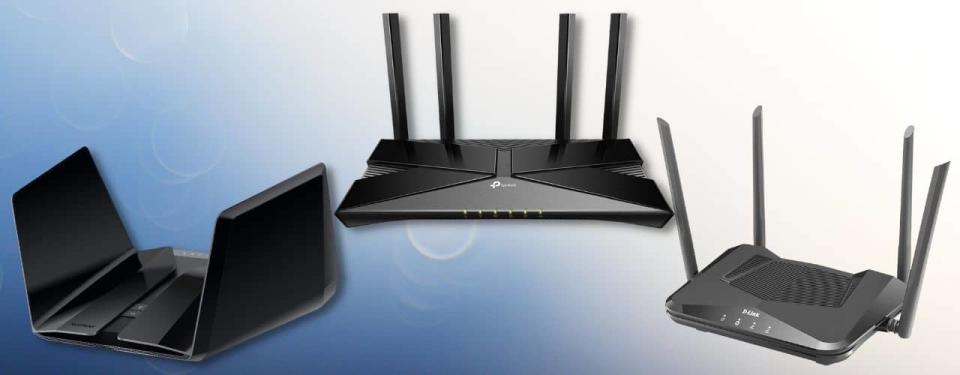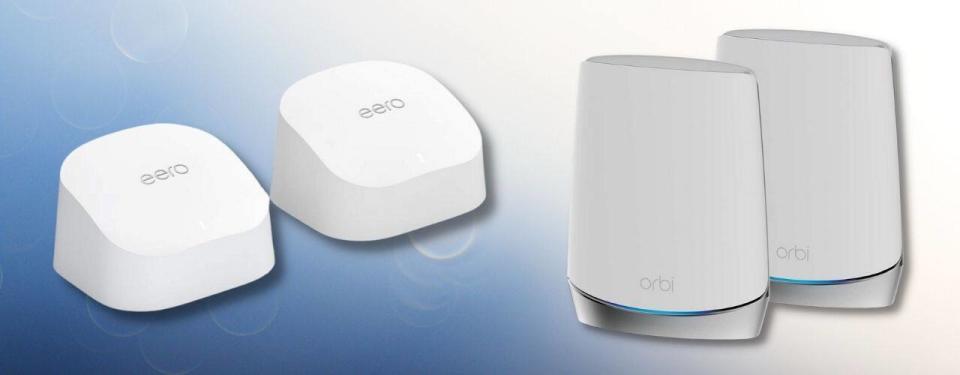Easy Tricks to Improve Your Wi-Fi On a Budget
Advertiser Disclosure: At Slickdeals, we work hard to find the best deals. Some products in our articles are from partners who may provide us with compensation, but this doesn’t change our opinions.

Before you read another word of this article, I want you to do one thing: go to your modem, pull the power cord to unplug it from the wall, count to ten, plug it back in and wait a minute or two while it restarts. For most Wi-Fi problems, resetting your modem in this manner will cure what ails you.
Still experiencing network issues after a restart? Keep reading and hopefully this guide will return you to networking nirvana, complete with router recommendations that can also help you get there. From dead spots and dropouts to choppy video streaming and laggy gaming, I’ve got fixes for the most common Wi-Fi problems.
I’ll offer some quick and easy ways you might be able to improve your home Wi-Fi situation without needing to buy anything. And if you determine you are in need of an upgrade, I’ve got some product suggestions at great prices.
Slow Speeds

With more people working from home and also entertaining themselves at home, having a reliable home wireless network is more important than ever. Suffering from a slow Internet connection is more than a mere annoyance if it is preventing you from doing your job, or at least making it more difficult and frustrating.
There are a few places to look first to speed up your Wi-Fi connection:
First question: how old is your modem? If you are renting a cable or satellite modem from your ISP, I’d call the company and ask if you can trade it in for a newer model. If you purchased your own modem, then it might be time for an upgrade if it’s been more than a couple years since you installed it.
If you aren’t using an outdated modem, then the culprit is likely your Wi-Fi router. Who knows, it could be older than your modem. Before you toss your router in the trash, however, try resetting it. There is usually a small button you can press with a paperclip to perform a factory reset, or a simple reset button that doesn’t require office supplies to press.
If resetting your router doesn’t speed things up and you’ve also tried resetting your modem, there’s one more thing to try before you declare your router a piece of junk that needs to be replaced. Establish a wired connection to your laptop. Most routers have at least one Ethernet port, so grab an Ethernet cable and see how your laptop acts with a wired connection. If it’s still slow, then the problem probably lies with your modem. If your laptop has a stable and speedy Internet connection via Ethernet, then your wireless signal is likely to blame and it might be time to upgrade to a new Wi-Fi router.
The current wireless standard is Wi-Fi 6, which you’ll also see referred to as 802.11ax. Wi-Fi 6 routers started rolling out about a year ago. The preceding Wi-Fi 5 (802.11ac) has been around since 2013. The chief advantage Wi-Fi 6 has over Wi-Fi 5 is a greater ability to manage a crowded network. With eight channels, Wi-Fi 6 offers twice as many lanes for routing network traffic as Wi-Fi 5. And it’s more adept at avoiding traffic jams on each lane. Wi-Fi 6 features MU-MIMO (multi-user, multiple input, multiple output) technology that allows more devices to operate more efficiently on each channel.

If you are working from home and also have a spouse on Zoom calls in the next room along with kids on Chromebooks distance learning from the kitchen or their bedrooms, then a Wi-Fi 6 router can make a huge difference for better managing your Wi-Fi traffic.
I’ve got two budget Wi-Fi 6 router suggestions and a pricier pick that’s currently discounted.
With a price that fluctuates between $70 and $100, this D-Link router is one of the least expensive entries into Wi-Fi 6 networking. It’s a 1.5Gbps, dual-band router that offers both speed and range, operating on the 5GHz and 2.4GHz frequencies. It offers four Gigabit Ethernet jacks for making wired connections to PCs, TVs and game consoles that need a strong, stable connection for streaming video and games. And it’s compatible with D-Link’s Exo mesh range extenders should you need to extend its range into the far corners of your house.
For roughly the same price as the D-Link router above, the TP-Link Archer AX10 is another budget option that covers the basics: dual bands with a maximum combined data rate of 1.5Gbps — 1.2Gbps on the 5GHz band and 300Mbps on the 2.4GHz band — along with four Gigabit Ethernet ports.
If you are willing to leave the budget category and spend more, then you can get a Wi-Fi 6 router that looks like a stealth bomber and provides eight antennas and 12 Wi-Fi streams. Currently discounted on Amazon, this dual-band Netgear Nighthawk router delivers speeds up to 6Gbps — 1.2Gbps on the 2.4GHz band and 4.8Gbps on the 5GHz band. It also supplies a pair of Ethernet ports if you’ve got a multi-gig Internet plan along with two USB ports for network-attached storage (NAS) drives.
Dead Spots

If your Wi-Fi works fine in your home office and living room but barely has a pulse upstairs in your bedroom or back office, then first let me compliment you on your large and well-appointed home. With those pleasantries out of the way, allow me to help you eradicate any Wi-Fi dead spots and broadcast a strong wireless signal throughout your house.
First, try repositioning your router. Is it tucked away in a closet or stuck in a corner in a room far from the center of your home? Router positioning matters. See if you can move it to an area with fewer physical obstructions that can block its signal. Perhaps you can run a longer cable from your modem to your router so you can put it in a spot where it can broadcast stronger signals to more areas of your house.
If moving your router around doesn’t improve your Netflix-viewing in bed or web browsing on your back patio, then you are a good candidate for a mesh system. A mesh system combines a main router with satellites that you place in other areas of your home to create a single network that reaches to every corner and floor of your living space.

This two-piece, Wi-Fi 6 mesh system features a router and similar-looking satellite that create a single wireless network to cover the entirety of almost any home — it offers speeds up to 4.2Gbps over the 5GHz and 2.4GH bands and covers 5,000 square feet of space. It also provides a bounty of wired options, with three Gigabit Ethernet ports on the router and two more on the satellite. It has a list price of $450 but it usually hovers between $380 and $400 on Amazon.
Don’t own a 5,000-square-foot abode? Amazon has its own mesh products, and this basic, two-piece eero mesh set is one of the least expensive Wi-Fi 6 mesh systems. This dual-band router and satellite costs only $200 and offers speeds up to 1.8Gbps and can cover up to 3,000 square feet of space.
Periodic Dropouts and Game Lag

If you experience Wi-Fi problems not in a particular spot in your house but during a particular time of day, then network traffic is likely the cause instead of your router’s range. Does your connection slow down in the evening when your various family members are watching Netflix, gaming online, playing on iPads, and browsing the web? If so, you might exceed your network’s bandwidth when everyone is accessing the Internet at the same time. And no one enjoys buffering during a good Netflix binge.
Dual-band routers as mentioned above operate on the 5GHz and 2.4Ghz bands. The 5GHz band is fast and free from interference from other devices in your home – microwaves, baby monitors, Bluetooth gadgets – that operate on the 2.4GHz frequency. The advantage of the 2.4GHz band is its greater ability to penetrate through walls and other physical barriers for better range. A tri-band router adds a second 5GHz band to the mix so you get two separate, high-speed networks for more bandwidth to divide among all of the Internet-connected devices in your home. More bandwidth means less buffering and more binging.
Before you replace your current router with a tri-band router, there are two ways you might be able to improve the network performance for the devices whose connection problems pain you the most, whether it’s streaming Netflix on your TV or gaming online with an Xbox, PS5 or PC.
The easiest way to boost the signal to a particular device is to drop the wireless connection in favor of a wired connection. If you can move your router or a mesh satellite near your TV, game console or gaming PC, then you can use an Ethernet cable to establish a wired connection — provided, of course, that your router has an Ethernet port.
If a wired connection isn’t feasible, then it might be worth your time to dig into your router’s settings. Look up your router’s model number and find its user manual so you can access its settings. Once there, look for Quality of Service (QoS) settings, which let you allocate bandwidth to certain devices. You can move, say, your TV to the top of the list so that when your kids are online upstairs while you are trying to watch Netflix, they don’t eat into your bandwidth and interrupt movie night.

If you are ready to make a hardware upgrade to prevent the Internet slowing to a standstill to the point where you frequently lose the connection, I’ve got a couple tri-band router recommendations.
Many tri-band routers are billed as “gaming routers” because of the extra, high-speed band is often used for lag-free gaming. That second 5GHz band is also beneficial if you enjoy watching movies and TV shows in smooth HD rather than suffering through a choppy, pixelated image. This tri-band ASUS router is currently discounted to $204 on Amazon and supports Wi-Fi 6 and covers 1,800 square feet. For larger homes, you can buy it as a two-piece mesh set, which is currently priced at $340 on Amazon.
Linksys Tri-Band WiFi Router for Home
If you are looking for an inexpensive way to improve the speed and reliability of your video streaming and online gaming, then this tri-band router from Linksys is a good pick. It doesn’t support Wi-Fi 6, but this 802.11ac (a.k.a Wi-Fi 5) router supplies two speedy 5GHz bands along with a 2.4GHz band for added range — it’s rated to cover 1,500 square feet.
More to consider:
How to Get Free Trials from the 22 Best Video Streaming Services
Where to Find the Best Discounts on The Amazon Fire TV Stick 4K
Get a Sam’s Club Membership Plus Up to $30 in Gift Cards, Pizza & Cake
Our editors strive to ensure that the information in this article is accurate as of the date published, but please keep in mind that offers can change. We encourage you to verify all terms and conditions of any product before you apply.

